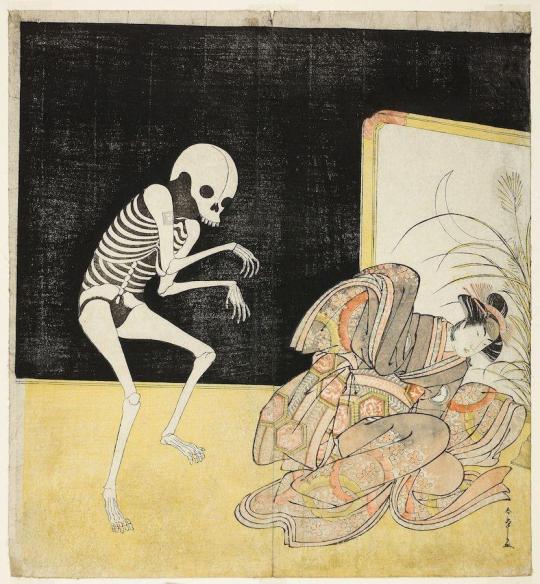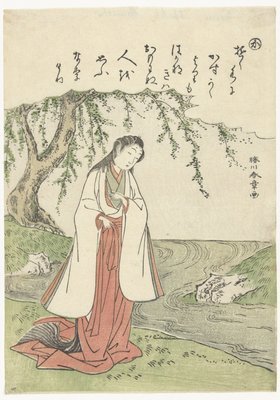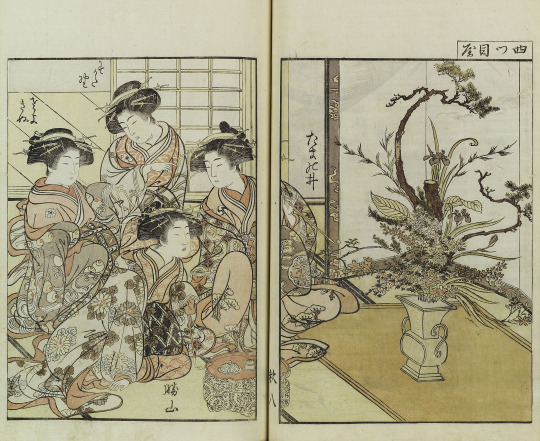#Katsukawa Shunsho
Explore tagged Tumblr posts
Photo

Chrysanthemums by Katsukawa Shunsho (Color woodblock print; surimono)
#art#artwork#kunst#kunstwerk#katsukawa shunsho#artist#künstler#asian art#asiatische kunst#nature#natur#flora#plants#pflanzen#leaves#blätter#flowers#blumen#chrysanthemums#chrysanthemen#blossoms#blüten#blooming#blühen#colors#farben#outdoors#draußen#botany#botanik
18 notes
·
View notes
Text

Katsukawa Shunshô, The Syllable I; Kasuga Village, from the series Tales of Ise, c.1770-73
22 notes
·
View notes
Photo
🌸



Katsukawa Shunshō, from Kôshoku zue jûnikô, ca. 1788, color woodblock, 25.6 x 39 cm.
206 notes
·
View notes
Text

1 note
·
View note
Photo

Spirit of the Renegade Monk, a woodblock print by Katsukawa Shunsho, 1783.
Buy as a print here on our online shop: https://t.co/L8ix4CujR8
579 notes
·
View notes
Text
The Daidarabotchi [Japanese folklore; yokai]

The easiest way to imagine a scary monster is to make it giant. It comes as no surprise then that many, if not most, cultures have some concept of giants in their religion or mythology.
The Daidarabotchi – also Daidarabocchi or Daidarabochi, among other variations – are colossal beings from Japanese folklore. They are a kind of nature spirits and appear in many different stories.
So huge were these giants that their movements shaped much of the world as it is today: when a Daidarabotchi walked, its footprints became ponds or even lakes. Many important Japanese landmarks, including Mount Fuji and Lake Biwa, were said to have been created by Daidarabotchi in the distant past. In fact, Mount Fuji was supposedly built in a single night.
In another story, one of these giants lifted up both Mount Tsukuba and Mount Fuji and placed them on a pair of enormous scales, so he could see which mountain was heavier.

In the 18th century Kaidan Hyakki Zue, the Daidarabotchi was depicted as a giant pitch-black humanoid creature. I don’t know if this is the first popular depiction of these creatures, but it caught on and became the standard look for these giants.
The Tearai Oni – which literally translates to ‘demon who washes its hands’ – is supposedly a member of this species. The Tearai Oni is a humongous creature known for its penchant for compulsively washing its hands in deep rivers, which it does by bending over backwards.
Among other places, a Daidarabotchi was said to inhabit the mountain Togakushi, which is supposedly a spiritual place inhabited by several kinds of supernatural beings.
Sources: Wakamori, T. (1989), The Hashira-Matsu and Shugendo, Japanese Journal of Religious Studies, 16, 181-194, p. 183-184. Davisson, Z. (2024), Ultimate Guide to Japanese Yokai, tuttle Publishing, 288 pp., p.193. Bane, T. (2016), Encyclopedia of Giants and Humanoids in Myth, Legend and Folklore, McFarland, 212 pp., p.51. Bane, T. (2016), Encyclopedia of Beasta and Monsters in Myth, Legend and Folklore, McFarland, 423 pp., p.311. (image source: TheJapanBox) (image: illustration from the 1798 Kaidan Hyakki Zue, Vol.1, by Katsukawa Shun’ei and Katsukawa Shunsho. Image taken from The Librarian Witch)
46 notes
·
View notes
Photo

The Actor Nakamura Noshio I as the Goddes Benzaiten of Enoshima in the Play Onno Aruji Hatsuyuki no Sekai, by Katsukawa Shunsho, ca. 1773, Japan
218 notes
·
View notes
Text

Ichikawa Danjūrō as a Skeleton, Spirit of the Renegade Monk Seigen, and Iwai Hanshirō IV as the Cherry Princess, in "Flower of Edo: An Ichikawa Saga"
Katsukawa Shunsho
Japan, 1783
10 notes
·
View notes
Text
Weekend treat: go see kabuki for the first time in Ginza and go check the murals of Ukiyo-e artists by Tamako Kataoka underground!
9/6/2024
It was my very first experience in kabuki although I'm Japanese. Since there are plenty of opportunities to gain experience of a variety of cultures even without going abroad all the way nowadays, I have been eager to make out of what I have right now, such as seeing famous Japanese art which tourists from other countries aspire to see in person or visiting historic places in Japan. Therefore, watching kabuki was being on my bucket list for so long. Then, I heard some useful information for that as a novice; Kabuki Theatre sells discount tickets for the upper gallery/single act(within 25 minutes)seats. This is so affordable even for me to dare to without sufficient knowledge.

So, I watched the act starting at 1:30pm, Yoshitsune and the Thousand Cherry Trees, which seemed relatively easy to comprehend as its story is partially based on The Gikeiki, a well-known Japanese war-tale focusing on the legends of Minamoto no Yoshitsune and his followers. Nevertheless, I prepared for this play by looking over some websites dedicated to its plot and characters.

Firstly, I was a bit shocked at the fact that spectators in the upper gallery cannot access to most of the inside from the entrance to the luxurious lobby nor use an elevator. I was actually looking forward to looking around the inside of the new building to my heart's content, though; it's completely separate and exclusive(but one day I'll come back to see a whole play). Anyways, as for kabuki, we barely saw the main stage as well as the extra stage called "hanamichi", and I enjoyed its every single detail comparing to elements of Noh, which I studied in college, and simply felt the beat. Regrettably, due to a single act seat, I couldn't see the highlights and the end, yet I was satisfied with my first time in Kabuki Theatre at least.
After that, I stopped by a Tokyo metro station closed to the theatre, Tsukijishijo station, in order to see the murals by one of my favorite Japanese painters Tamako Kataoka(1905-2008) in person. She had great respect for Ukiyo-e or Japanese traditional performing arts, contributing the artwork below to the place where such Edo culture had been being developed. No one was even taking a glance at it there, whereas I alone took pictures of it in earnest(ridiculously); even if no one cares, I do care.

"Tsuragamae: Katsukawa Shunsho"(1987), "Tsuragamae: Toyokuni Utagawa"(1976)
#weekend treat#short trips#tokyo#japan#kabuki theatre#kabuki#ginza#tokyo metro#wall murals#ukiyoe#tamako kataoka#minamoto no yoshitsune#traditional arts#japanese art#edo period
4 notes
·
View notes
Text
May 22 - Imperial Palace and Kyoto National Museum
Before our class meeting this morning, my roommate and I stopped in Family Mart to grab a coffee and a quick bite to eat. First, our class went to the Kyoto Imperial Palace. We went on an English walking tour; it was pretty hot outside, but it was cool to actually be able to walk through the palace grounds. It definitely felt like the most touristy thing that I have done while in Tokyo, just because our walking tour was mostly foreigners and tourists. After the imperial palace, we went to the Kyoto National Museum. There, we walked around the three floors. Something that was different about this museum was that no phones were allowed, and therefore no photos. I brought around a notepad and a pen to write down the names of works that caught my attention. I bought a couple of souvenirs at the museum’s gift shop, but my favorite thing I got was a print. I usually get a print from every museum I visit, and since I did not find a print I wanted at the museum in Tokyo, I felt that I should buy a print here if I found one I liked. My friends and I reconvened at the gates of the museum, and we walked the route back to the train station in search of a lunch spot. Four of my friends and I ate at a ramen spot, and something I have found to be different here in Japan from America is that restaurants here are less likely to accommodate large parties. At this ramen spot, our group of five had to split into a pair and a group of three. Restaurants here are definitely less likely than places in America to do things like push tables together or pull up chairs to accommodate larger parties. For my meal, I had ramen and a Coke. The ramen was good and the Coke refreshed me after a hot day! My friends and I were planning on going to Hiroshima, but we ended up staying in Kyoto instead. We walked around Kyoto Station a little bit before walking to a nearby aquarium. Some of the animals, like the penguins and salamanders, looked like they were cramped which made me feel upset for them, but I enjoyed seeing all of the different kinds of jellyfish they had. At the aquarium café, my friends and I had Dippin Dots. Before we left the aquarium, we browsed around the gift shops and took pictures in a cute photo booth. For dinner, I got some things from Family Mart and the MOS Burger by our hotel. Tomorrow, I am going to the Ghibli Museum which I am really excited for!!











Academic Reflection:
The piece that stood out to me at the Kyoto National Museum was “First Shrine Visit”, by Katsukawa Shunsho, which was ink and colors on silk. It seemed to chronicle a story through its depiction of a sequence of events: a matchmaking meeting, wedding ceremony, childbirth, and the child’s first visit to a shrine. The piece was displayed like an unfurling scroll which added to the narrative feeling I felt looking at it. I learned that a child’s first visit to a shrine is significant in its commemoration of growth for them as they reach different age milestones. The practice is called shichi-go-san and is a lasting memory for a family in Japan, as it celebrates the child and the family’s bond. I was drawn to this piece by its storytelling in its display and separation of scenes as well as its emphasis of Japanese familial/cultural traditions and norms.
At the Kyoto Imperial Palace, we were able to see where a corridor was removed from the palace grounds. In 1945, during World War II, many of the corridors connecting the different buildings/rooms of the palace were removed. The corridors were constructed so that the emperor’s feet would never touch the ground, but they put the entire palace at risk in cases of fire. In Morris’ “World Shining Prince”, I read that earthquakes and fires would occur relatively quickly, so I was able to draw this connection to the construction and renovation of the imperial palace. We were also able to see the shutters that separated the inside and outside of the palace. In the reading, these shutters were common in traditional Japanese architecture. These shutters were able to be rolled up in warm weather and then brought down in colder weather. This element of Japanese architecture reinforced my preconception of a strong connection between Japanese culture and nature.
1 note
·
View note
Photo

Woman at River Ka by Katsukawa Shunsho (paper)
#art#artwork#kunst#kunstwerk#katsukawa shunsho#artist#künstler#asian art#asiatische kunst#woman#frau#portrait#porträt#beauty#schönheit#nature#natur#river#fluss#river ka#grass#gras#standing#stehen#tree#baum#plants#pflanzen#art prints#kunstdrucke
8 notes
·
View notes
Text

Ichimura Uzaemon IX as Soga no Juro, Katsukawa Shunsho, 1774
#art#art history#Asian art#Japan#Japanese art#East Asia#East Asian art#ukiyo-e#woodblock print#Katsukawa Shunsho#Katsukawa School#kabuki#portrait#Edo period#18th century art#Cleveland Museum of Art
66 notes
·
View notes
Photo

(r–l) The Courtesans Tamanoi, Katsuyama, Sugatano, and Sayoginu of Yotsumeya Artists: Katsukawa Shunshо̄ (Japanese; 1726–1792) and Kitao Shigemasa (Japanese; 1739–1820) In: Mirror of the Forms of Fair Women of the Green Houses (Volume 2) Color woodblock print book Publisher: Tsutaya Jūzaburо̄ and Yamazaki Kinbē (Edo, 1776) The New York Public Library, Spencer Collection
#Katsukawa Shunshо̄#Katsukawa Shunsho#Kitao Shigemasa#Shigemasa#Shunshо̄#Shunshо#Tsutaya Jūzaburо̄#Tsutaya Juzaburo#Japanese art#Japanese artists#Japanese books#Japanese prints#ehon#illustrated books#picture albums#prints and printmakers#courtesans#woodblock prints#ukiyo-e#flowers#flower arrangements#vases#1770s#Yotsumeya#artists' books#Japanese artists' books#18th century#18th-century Japanese art#18th-century Japanese books#courtesan books
15 notes
·
View notes
Photo

Spirit of the Renegade Monk, a woodblock print by Katsukawa Shunsho, 1783.
Buy as a print here on our online shop: https://t.co/L8ix4CujR8
446 notes
·
View notes
Text

Dancer with a chrysanthemum by Katsukawa Shunsho (1726-1793)
179 notes
·
View notes
